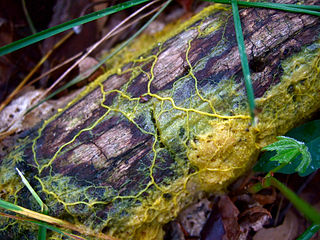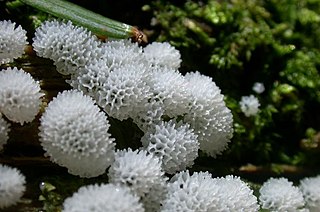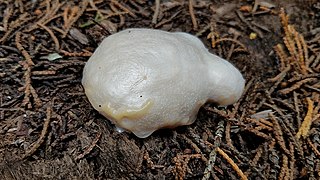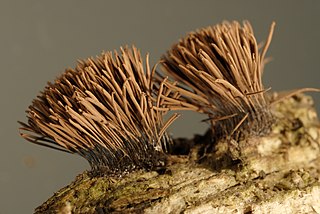
Slime mold or slime mould is an informal name given to several kinds of unrelated eukaryotic organisms with a life cycle that includes a free-living single-celled stage and the formation of spores. Spores are often produced in macroscopic multicellular or multinucleate fruiting bodies which may be formed through aggregation or fusion. Slime molds were formerly classified as fungi but are no longer considered part of that kingdom. Although not forming a single monophyletic clade, they are grouped within the paraphyletic group Protista.

Mycetozoa is a polyphyletic grouping of slime molds. It was originally thought to be a monophyletic clade, but recently it was discovered that protostelia are a polyphyletic group within Conosa.

Physarum polycephalum, an acellular slime mold or myxomycete popularly known as "the blob", is a protist with diverse cellular forms and broad geographic distribution. The “acellular” moniker derives from the plasmodial stage of the life cycle: the plasmodium is a bright yellow macroscopic multinucleate coenocyte shaped in a network of interlaced tubes. This stage of the life cycle, along with its preference for damp shady habitats, likely contributed to the original mischaracterization of the organism as a fungus. P. polycephalum is used as a model organism for research into motility, cellular differentiation, chemotaxis, cellular compatibility, and the cell cycle.

Lycogala epidendrum, commonly known as wolf's milk or groening's slime, is a cosmopolitan species of myxogastrid amoeba which is often mistaken for a fungus. The aethalia, or fruiting bodies, occur either scattered or in groups on damp rotten wood, especially on large logs, from June to November. These aethalia are small, pink to brown cushion-like blobs. They may ooze a pink "paste" if the outer wall is broken before maturity. When mature, the colour tends to become more brownish. When not fruiting, single celled individuals move about as very small, red amoeba-like organisms called plasmodia, masses of protoplasm that engulf bacteria, as well as fungal and plant spores, protozoa, and particles of non-living organic matter through phagocytosis.

Physarum is a genus of mycetozoan slime molds in the family Physaraceae.

Fuligo septica is a species of slime mold, and a member of the class Myxomycetes. It is commonly known as scrambled egg slime, or flowers of tan because of its peculiar yellowish appearance. It is also known as dog vomit slime mold or Jasmine mold and is relatively common with a worldwide distribution, often being found on bark mulch in urban areas after heavy rain or excessive watering. Their spores are produced on or in aerial sporangia and are spread by wind.

Protosteliomycetes/Protosteliales (ICBN) or Protostelea/Protostelia/Protosteliida (ICZN) is a grouping of slime molds from the phylum Mycetozoa. The name can vary depending upon the taxon used. Other names include Protostelea, Protostelia, and Protostelida. When not implying a specific level of classification, the term protostelid or protosteloid amoeba is sometimes used.

Myxogastria/Myxogastrea or Myxomycetes (ICN), is a class of slime molds that contains 5 orders, 14 families, 62 genera, and 888 species. They are colloquially known as the plasmodial or acellular slime moulds.

Echinostelium is a genus of slime mould, and the only genus in the monotypic family Echinosteliaceae, or Echinosteliidae. It was discovered by Heinrich Anton de Bary in 1855, apparently near Frankfurt am Main. Some species of Echinostelium have a sexual life cycle; others have been shown to be asexual. The plasmodium can divide vegetatively, in a process called plasmotomy, to distinguish it from true cell division.

Trichiales is an order of slime moulds in the phylum Amoebozoa. Trichiales is one of five orders in the group Myxomycetes, or the true plasmodial slime molds. It is also currently categorized under the superorder Lucisporidia with its sister group, Liceales. The order was first described by Thomas MacBride in 1922, and has retained the same name and status as a defined order in present phylogeny. In the plasmodium form, members of Trichiales lack a columella but have a well-developed capillitium for spore dispersal. The shape and details of the capillitium are used to define families within the order. Spores are brightly coloured, ranging from clear, white and yellow to pink and red-brown tones. The order currently has 4 families, 14 genera and 174 species. Recent molecular research has shown that while Trichiales probably represents a true taxonomic group, its sister group Liceales is likely paraphyletic, and it has been suggested that several genera from the Liceales should be reclassified under Trichiales instead.

Enteridium lycoperdon, the false puffball, is one of the more obvious species of slime mould or Myxogastria, typically seen in its reproductive phase as a white 'swelling' on standing dead trees in the spring, or on large pieces of fallen wood. Alder is a common host.

Brefeldia maxima is a species of non-parasitic plasmodial slime mold, and a member of the class Myxomycetes. It is commonly known as the tapioca slime mold because of its peculiar pure white, tapioca pudding-like appearance. A common species with a worldwide distribution, particularly in North America and Europe. It is often found on bark after heavy rain or excessive watering. Their spores are produced on or in aerial sporangia and are spread by wind, however beetles of the family Latridiidae are also reported to disperse the spores. Bonner states that soil invertebrates and rain mainly disperse spores as they are sticky and unlikely to be carried by air currents.

In true slime molds (myxogastria), lichens, and in species of the family Clavicipitaceae, the hypothallus is the layer on which the fruit body sits, lying in contact with the substrate. The word is derived from the Ancient Greek root hypó ("under") and thallós.

Trichia decipiens is a worldwide widespread slime mould species from the order Trichiida.
Physarum aeneum is a slime mould species from the order Physarida. It is one of a few slime moulds mainly common in the tropics and subtropics.

Stemonitis axifera is a species of slime mold. It fruits in clusters on dead wood, and has distinctive tall reddish-brown sporangia, supported on slender stalks.
Henry Carl Aldrich was an American mycologist born in Beaumont, Texas.

Physaraceae is a family of slime molds in the order Physarales.

Hemitrichia is a genus of slime molds, of the family Trichiidae, found within the order Trichiida. It was first described by Josef Rostafinksi in 1873 and remains a well-defined genus of the slime molds. Hemitrichia species exhibit either plasmodiocarp or sporangium fruiting bodies, both of which are well-known and recognizable slime molds seen on multiple continents. The genus includes Hemtrichia serpula, known as the pretzel slime mold, an iconic and widespread species that has been used to examine speciation in slime molds.

Elaeomyxa is a genus of slime molds in the family Lamprodermataceae. As of May 2022, there are four known species in the genus. Species in this genus have been documented in North America, Eurasia, Africa, and Australasia.


















